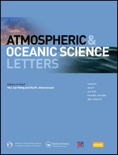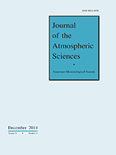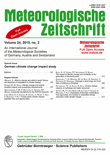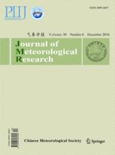
Asia-Pacific Journal of Atmospheric Sciences
Scope & Guideline
Pioneering Insights for a Sustainable Future
Introduction
Aims and Scopes
- Atmospheric Modeling and Simulation:
The journal emphasizes the development and application of numerical models for simulating atmospheric processes, including weather forecasting and climate projections. - Extreme Weather and Climate Events:
Research on extreme weather phenomena, such as typhoons, heavy rainfall, and heatwaves, is a core area, addressing both historical data and predictive modeling. - Climate Change Impacts:
Investigations into the effects of climate change on regional weather patterns, including temperature and precipitation extremes, are prevalent, highlighting the journal's commitment to understanding and projecting future climatic scenarios. - Air Quality and Pollution Studies:
The journal covers studies related to atmospheric pollutants, including PM2.5 and other particulate matters, and their sources, impacts on health, and mitigation strategies. - Hydrometeorology and Precipitation Dynamics:
Research focusing on precipitation processes, including rainfall distribution and intensity, as well as hydrological impacts on various ecosystems, is frequently featured. - Regional Climate Variability:
The journal addresses the spatial and temporal variability of climate across the Asia-Pacific region, including teleconnections with global climate patterns. - Data Assimilation and Remote Sensing:
Utilization of advanced technologies for atmospheric observations, including satellite data and ground-based measurements, is critical for improving model accuracy and understanding atmospheric dynamics.
Trending and Emerging
- Machine Learning Applications in Meteorology:
The integration of machine learning techniques for weather prediction, air quality forecasting, and data assimilation is on the rise, showcasing innovative approaches to atmospheric sciences. - Impact of Urbanization on Climate:
Research examining the influence of urbanization on local and regional climates, particularly concerning urban heat islands and air quality, has gained significant attention. - Climate Change Adaptation and Resilience:
Studies focusing on adaptation strategies for climate resilience, especially in vulnerable regions of the Asia-Pacific, are becoming increasingly prominent as communities seek to mitigate the impacts of climate change. - Multi-Hazard Risk Assessment:
There is a growing trend towards assessing and managing risks associated with multiple hazards, such as floods, droughts, and typhoons, reflecting the interconnected nature of climate impacts. - Atmospheric Rivers and Extreme Precipitation:
Research on atmospheric rivers and their role in extreme precipitation events is emerging as a critical area of study, particularly concerning their impacts on regional hydrology. - Synergistic Effects of Climate and Pollution:
The interplay between climate change and air pollution, particularly in urban settings, is increasingly recognized as a vital area of investigation with significant public health implications.
Declining or Waning
- Historical Climate Studies:
Research focused on historical climate patterns and past climate events appears to be waning, possibly due to a greater emphasis on real-time data analysis and future projections. - Localized Case Studies:
There is a noticeable reduction in papers concentrating on localized atmospheric phenomena without broader implications, as the journal increasingly favors studies that connect local events to regional or global trends. - Traditional Statistical Methods:
The use of traditional statistical analysis methods for climate data interpretation has decreased, with a shift towards machine learning and advanced computational techniques gaining traction. - General Climate Models without Region-Specific Adaptation:
There is a declining interest in generic global climate models that do not incorporate region-specific adaptations, as researchers seek more localized and applicable modeling approaches.
Similar Journals

Atmospheric and Oceanic Science Letters
Illuminating Atmospheric and Oceanic InteractionsAtmospheric and Oceanic Science Letters is a premier open-access journal dedicated to the rapidly evolving fields of atmospheric science and oceanography. Published by KEAI PUBLISHING LTD, this journal aims to foster research dissemination and collaboration by providing a platform for high-quality research articles, reviews, and case studies that address critical issues impacting atmospheric and oceanic systems. With an impressive impact factor reflecting its esteemed position—including being ranked Q2 in Atmospheric Science and Q1 in Oceanography in 2023—this journal is an essential resource for researchers, professionals, and students alike. The journal's Open Access model, adopted since 2016, ensures that groundbreaking research is readily available to a global audience, enhancing knowledge transfer and facilitating innovative solutions to environmental challenges. Operating out of the United Kingdom and reaching an international readership, Atmospheric and Oceanic Science Letters plays a pivotal role in shaping our understanding of the interactions between the atmosphere and oceans, making it a vital publication for anyone aiming to stay at the forefront of these dynamic scientific fields.

JOURNAL OF THE ATMOSPHERIC SCIENCES
Advancing the Frontiers of Atmospheric ResearchJOURNAL OF THE ATMOSPHERIC SCIENCES, published by the American Meteorological Society, stands as a premier resource for the latest research in atmospheric sciences. With an impressive impact factor and a Q1 ranking in the Atmospheric Science category for 2023, this journal is recognized for its rigorous peer-reviewed articles that contribute to the understanding and advancement of weather, climate, and dynamics of the atmosphere. Established in 1969, the journal has maintained high academic standards and delivers valuable insights spanning over five decades, thus catering to an audience of researchers, professionals, and students alike. Although it does not offer open-access options, it provides critical access through various institutional subscriptions, ensuring that significant research findings are disseminated widely within the scientific community. The journal's address is located at 45 Beacon St, Boston, MA 02108-3693, United States, and it accepts submissions and articles until 2024, continuing its legacy of excellence in atmospheric research.

Tethys-Journal of Mediterranean Meteorology & Climatology
Navigating the Future of Mediterranean Climate ResearchTethys - Journal of Mediterranean Meteorology & Climatology, published by the Associació Catalana de Meteorologia (ACAM), serves as a specialized platform dedicated to advancing the study of meteorological and climatological phenomena within the Mediterranean region. With a Scopus Rank of #94 out of 148 in the field of Atmospheric Science, this journal is positioned in the Q4 category, reflecting a growing recognition among researchers focused on regional climate variations and environmental challenges. Established in 2012 and publishing through 2023, Tethys aims to provide open access to high-quality research articles that address critical issues impacting climate and weather patterns, thus contributing to a deeper understanding of Mediterranean meteorology. The journal’s mission aligns closely with the increasing global emphasis on climate studies and serves as an essential resource for academics, practitioners, and students dedicated to sustainably addressing the environmental and climatic challenges faced by this diverse and dynamic region.

METEOROLOGISCHE ZEITSCHRIFT
Charting New Territories in Meteorological StudiesMETEOROLOGISCHE ZEITSCHRIFT is a distinguished academic journal dedicated to the field of meteorology and atmospheric sciences, published by E SCHWEIZERBARTSCHE VERLAGSBUCHHANDLUNG. With an ISSN of 0941-2948 and an E-ISSN of 1610-1227, this journal has been an invaluable resource for researchers, professionals, and students since its inception. It has embraced an Open Access model since 2014, promoting wider dissemination of research findings. Based in Stuttgart, Germany, the journal is recognized for its rigorous peer-review process and is currently positioned in the Q3 quartile for Atmospheric Science as per the 2023 category rankings. Additionally, it ranks #97 out of 148 in the Scopus database, placing it in the 34th percentile among Earth and Planetary Sciences. Covering a broad spectrum of topics relevant to meteorology, METEOROLOGISCHE ZEITSCHRIFT serves as a platform for innovative research and theoretical contributions, aiming to advance understanding of atmospheric phenomena and their implications for climate and weather. Researchers and practitioners alike will find valuable insights within its pages, making it a significant asset in the landscape of meteorological scholarship.

Weather and Climate
Pioneering Research for a Sustainable FutureWeather and Climate is a prestigious, peer-reviewed journal published by the Meteorological Society of New Zealand, dedicated to advancing knowledge in the domains of meteorology and climatology. With the ISSN 0111-5499, the journal serves as a vital platform for researchers and professionals to disseminate impactful findings that address pressing issues related to weather patterns and climate change. Although it does not operate on an open-access model, it provides a wealth of valuable insights drawn from a diverse range of studies. The significance of this journal in the scientific community is underscored by its commitment to fostering interdisciplinary collaboration and sharing innovative research that can inform policy-making and environmental management strategies. Located in Wellington, New Zealand, Weather and Climate not only contributes to regional meteorological discourse but also holds relevance for the global scientific landscape, making it essential reading for anyone invested in the future of our changing climate.

Idojaras
Elevating the discourse in weather and climate studies.Idojaras, a prominent journal published by the Hungarian Meteorological Service, has been a vital contributor to the field of Atmospheric Science since its inception in 1980. With a specific focus on the intricacies of weather phenomena, climate variability, and environmental change, this journal serves as a platform for researchers and professionals to disseminate their findings. Although currently categorized in Q4 of Atmospheric Science with a Scopus rank of #122 out of 148, Idojaras is dedicated to improving its impact and visibility through rigorous peer-reviewed research and comprehensive analyses that engage a global audience. This scholarly publication, which operates without open access, is pivotal for advancing knowledge in meteorological studies, thereby appealing not only to seasoned scientists but also to students and scholars eager to explore this dynamic field. Located in Budapest, Hungary, the journal continues to strive for excellence in its coverage through the convergence of past and present meteorological research, making it a significant resource for anyone interested in the atmospheric sciences.

Journal of Meteorological Research
Advancing the Frontiers of Atmospheric Science.The Journal of Meteorological Research, published by SPRINGER HEIDELBERG, stands as a vital resource in the fields of Atmospheric Science and Ocean Engineering, boasting an impressive impact factor that reflects its scholarly significance. With its ISSN 2095-6037 and E-ISSN 2198-0934, the journal offers an open access platform, fostering accessibility and dissemination of cutting-edge research. Established in 2014 and running through to 2024, it is particularly distinguished in 2023 as Q2 in Atmospheric Science and Q1 in Ocean Engineering, underscoring its important contributions to these disciplines, with remarkable rankings in Scopus that place it in the top tiers of both categories. The journal accepts a broad range of research articles, reviews, and innovative methodologies, catering to a diverse audience of researchers, professionals, and students eager to advance their knowledge and expertise in meteorological studies. This makes the Journal of Meteorological Research an essential platform for anyone engaged in understanding and addressing the complex challenges of our changing climate.

TERRESTRIAL ATMOSPHERIC AND OCEANIC SCIENCES
Transforming Insights into Actionable KnowledgeTERRESTRIAL ATMOSPHERIC AND OCEANIC SCIENCES, published by SpringerNature, is a distinguished peer-reviewed journal that has been an essential platform for innovative research in the fields of atmospheric science, oceanography, and Earth and planetary sciences since its inception. With an Open Access policy established in 1990, the journal ensures wide dissemination of knowledge, allowing researchers, professionals, and students to access cutting-edge findings without restrictions. Based in Switzerland and featuring a comprehensive coverage from 1996 to 2024, the journal currently holds a Q3 ranking across various categories, indicating its growing significance in the scientific community. Although it is positioned within the 39th percentile in Earth and Planetary Sciences, its commitment to fostering high-quality research makes it a valuable resource for advancing understanding of terrestrial environments and their interconnections. Researchers seeking a platform for their work in atmospheric and oceanic sciences will find TERRESTRIAL ATMOSPHERIC AND OCEANIC SCIENCES to be an ideal venue for sharing their insights with a global audience.

Weather and Climate Dynamics
Unraveling the Complexities of Weather and ClimateWeather and Climate Dynamics, an esteemed journal published by COPERNICUS GESELLSCHAFT MBH, focuses on the intricate relationships and processes governing climate and weather patterns, advancing our understanding of atmospheric sciences. Since its launch in 2020, this Open Access journal has rapidly gained recognition, achieving a commendable Q1 status in Atmospheric Science and ranking 39th out of 148 journals in the Earth and Planetary Sciences category, placing it in the 73rd percentile. Based in Germany, the journal aims to provide a platform for innovative research, sharing crucial findings that contribute to tackling global climate challenges. Researchers, professionals, and students alike are encouraged to explore the wealth of knowledge contained within its pages, as it continues to shape the discourse on weather and climate dynamics through rigorous and impactful scholarship.

JOURNAL OF HYDROMETEOROLOGY
Charting New Territories in HydrometeorologyJOURNAL OF HYDROMETEOROLOGY, published by the American Meteorological Society, is a leading scholarly journal that serves as a vital resource within the field of atmospheric science. With its ISSN 1525-755X and E-ISSN 1525-7541, this journal provides a platform for the dissemination of high-impact research, currently holding a prestigious Q1 ranking in Atmospheric Science as per the 2023 Category Quartiles. It enjoys an excellent reputation, ranked #30 out of 148 in the Scopus listings, placing it in the top 80th percentile within Earth and Planetary Sciences. Publishing rigorous and innovative studies from 2000 to 2024 and beyond, the journal addresses critical topics including weather forecasting, climate dynamics, and hydrological processes, making it essential reading for researchers, professionals, and students alike. Though not an open-access journal, it continues to enrich the academic community with quality contributions dedicated to advancing our understanding of hydrometeorological phenomena.